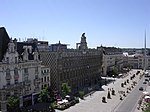Stade Nungesser
1930 establishments in FranceBuildings and structures in ValenciennesFootball venues in FranceFrench sports venue stubsSports venues completed in 1930 ... and 2 more
Sports venues in Nord (French department)Valenciennes FC

Stade Nungesser was a multi-use stadium in Valenciennes, France. It is currently used mostly for football matches and was the home stadium of Valenciennes FC through the 2010–11 season. The stadium is able to hold 16,457 people and was built in 1930. It was replaced as VAFC's main ground by the Stade du Hainaut in July 2011. The stadium is named after the ace pilot Charles Nungesser, who was born in Valenciennes.
Excerpt from the Wikipedia article Stade Nungesser (License: CC BY-SA 3.0, Authors, Images).Stade Nungesser
Rue François Coli, Valenciennes
Geographical coordinates (GPS) Address Phone number Website Nearby Places Show on map
Geographical coordinates (GPS)
| Latitude | Longitude |
|---|---|
| N 50.348925 ° | E 3.526847 ° |
Address
Centre aquatique Nungesser
Rue François Coli 260
59300 Valenciennes, Faubourg de Cambrai
Hauts-de-France, France
Open on Google Maps









